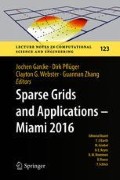Abstract
Sparse grid interpolants of high-dimensional functions do not maintain the range of function values. This is a core problem when one is dealing with probability density functions, for example. We present a novel approach to limit range of function values of sparse grid surrogates. It is based on computing minimal sets of sparse grid indices that extend the original sparse grid with properly chosen coefficients such that the function value range of the resulting surrogate function is limited to a certain interval. We provide the prerequisites for the existence of minimal extension sets and formally derive the intersection search algorithm that computes them efficiently. The main advantage of this approach is that the surrogate remains a linear combination of basis functions and, therefore, any problem specific post-processing operation such as evaluation, quadrature, differentiation, regression, density estimation, etc. can remain unchanged. Our sparse grid approach is applicable to arbitrarily refined sparse grids.
Access this chapter
Tax calculation will be finalised at checkout
Purchases are for personal use only
References
H.-J. Bungartz, M. Griebel, Sparse grids. Acta Numer. 13, 147–269 (2004)
C. Feuersänger, Sparse grid methods for higher dimensional approximation. Ph.D. thesis, Rheinischen Friedrich–Wilhelms–Universität Bonn, 2010
F. Franzelin, D. Pflüger, From data to uncertainty: an efficient integrated data-driven sparse grid approach to propagate uncertainty, in Sparse Grids and Applications - Stuttgart 2014, ed. by J. Garcke, D. Pflüger (Springer International Publishing, Cham, 2016), pp. 29–49
F. Franzelin, P. Diehl, D. Pflüger, Non-intrusive uncertainty quantification with sparse grids for multivariate peridynamic simulations, in Meshfree Methods for Partial Differential Equations VII, ed. by M. Griebel, M. A. Schweitzer. Lecture Notes in Computational Science and Engineering, vol. 100 (Springer International Publishing, Berlin, 2015), pp. 115–143
M. Frommert, D. Pflüger, T. Riller, M. Reinecke, H.-J. Bungartz, T. Enßlin, Efficient cosmological parameter sampling using sparse grids. Mon. Not. R. Astron. Soc. 406(2), 1177–1189 (2010)
J. Garcke, Maschinelles Lernen durch Funktionsrekonstruktion mit verallgemeinerten dünnen Gittern. Ph.D. thesis, University of Bonn, Institute for Numerical Simulation, 2004
M. Griebel, M. Hegland, A finite element method for density estimation with Gaussian process priors. SIAM J. Numer. Anal. 47(6), 4759–4792 (2010)
M. Hegland, G. Hooker, S. Roberts, Finite element thin plate splines in density estimation. ANZIAM J. 42, 712–734 (2000)
B. Peherstorfer, D. Pflüger, H.-J. Bungartz, Clustering based on density estimation with sparse grids, in KI 2012: Advances in Artificial Intelligence, ed. by B. Glimm, A. Krüger. Lecture Notes in Computer Science, vol. 7526 (Springer, Berlin, 2012), pp. 131–142
B. Peherstorfer, F. Franzelin, D. Pflüger, H.-J. Bungartz, Classification with Probability Density Estimation on Sparse Grids (Springer International Publishing, Cham, 2014), pp. 255–270
B. Peherstorfer, D. Pflüger, H.-J. Bungartz, Density estimation with adaptive sparse grids for large data sets, in Proceedings of the 2014 SIAM International Conference on Data Mining (2014), pp. 443–451
D. Pflüger, Spatially Adaptive Sparse Grids for High-Dimensional Problems (Verlag Dr. Hut, München, 2010)
Acknowledgements
The authors acknowledge the German Research Foundation (DFG) for its financial support of the project within the Cluster of Excellence in Simulation Technology at the University of Stuttgart.
Author information
Authors and Affiliations
Corresponding author
Editor information
Editors and Affiliations
Rights and permissions
Copyright information
© 2018 Springer International Publishing AG, part of Springer Nature
About this paper
Cite this paper
Franzelin, F., Pflüger, D. (2018). Limiting Ranges of Function Values of Sparse Grid Surrogates. In: Garcke, J., Pflüger, D., Webster, C., Zhang, G. (eds) Sparse Grids and Applications - Miami 2016. Lecture Notes in Computational Science and Engineering, vol 123. Springer, Cham. https://doi.org/10.1007/978-3-319-75426-0_4
Download citation
DOI: https://doi.org/10.1007/978-3-319-75426-0_4
Published:
Publisher Name: Springer, Cham
Print ISBN: 978-3-319-75425-3
Online ISBN: 978-3-319-75426-0
eBook Packages: Mathematics and StatisticsMathematics and Statistics (R0)

